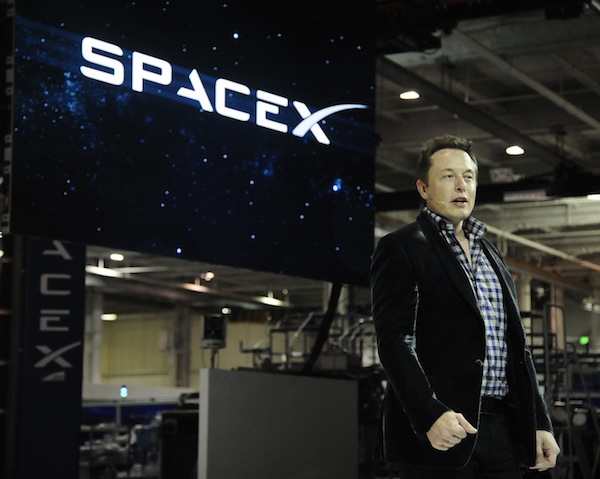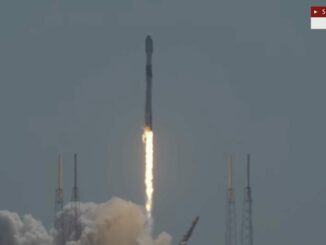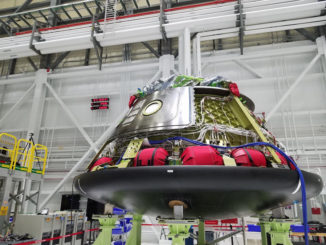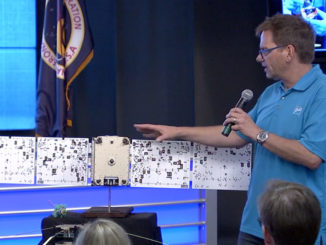Updated at 9 p.m. EDT with SpaceX statement
A faulty support strut inside the Falcon 9 rocket’s second stage liquid oxygen tank likely broke free during a June 28 space station resupply launch, destroying the booster minutes after liftoff in a cloud of debris over the Atlantic Ocean, SpaceX chief Elon Musk said Monday.
While noting the investigation into last month’s failure is not complete, Musk told reporters Monday the evidence shows a weakened bracket holding a high-pressure helium vessel inside the Falcon 9’s second stage is the likely culprit.
Several helium tanks, each pressurized to about 5,500 pounds per square inch, are mounted inside the rocket’s second stage liquid oxygen tank. The helium is routed through the second stage’s Merlin engine, where the helium warms up and injected into the rocket’s propellant tanks to pressurize the stage as the launcher burns fuel, keeping the tanks structurally sound.
Musk said SpaceX engineers analyzing extensive telemetry data from the rocket, along with physical testing on the ground, concluded a support strut holding one of the helium tanks likely fractured near a bolt attach point.
The high-pressure helium tank, immersed inside the super-cold liquid oxygen, wanted to shoot to the top of the stage, similar to the way an inflated beach ball rises to the surface of a swimming pool, Musk said.
“It may seem sort of counterintuitive that, as the rocket’s accelerating, that something immersed in the tank would actually want to go up more, but that’s basically what happened,” Musk said. “The buoyancy increases proprotionate to the G-loading. At approximately 3.2 Gs, this strut holding down one of the helium bottles appears to have snapped, and as a result, releasing a lot of helium into the upper stage oxygen tank and causing an over-pressure event quite quickly.”
Musk said less than nine-tenths of a second passed from the first indication of a problem until the data link between the rocket and mission control cut off.
Telemetry logged from the June 28 launch showed a momentary drop in helium pressure, then a rise back to the system’s starting pressure, Musk said, initially puzzling investigators probing the mishap.
One explanation for the data signature is that the tank broke free, introducing helium into the liquid oxygen tank until a kink in a feed line stopped the leak, allowing pressure in the helium system to rise again.
The failure occurred 2 minutes, 18 seconds after liftoff from Cape Canaveral, when the Falcon 9’s nine first stage Merlin engines were still firing, according to a SpaceX statement released Monday. Because the second stage was not ignited, the propellant tanks were full, leaving little room to add high-pressure gas before rupturing the stage.
“Within the course of a second, this caused enough helium to be released, we believe, to over-pressurize the liquid oxygen tank in the upper stage,” Musk said. “You don’t really need to release a lot of helium because there’s only about 2 percent gaseous volume in the stage because the upper stage propellant is not being consumed.”
SpaceX engineers, who are working with NASA, the U.S. Air Force and the FAA in the investigation, have no other smoking gun on a source for last month’s failure.
“There are just things that make (the strut explanation) more probable rather than less probable,” Musk said, explaining a analysis method he called “acoustic triangulation.”
“We’ve got microphones, technically accelerometers, at various points on the upper stage, and by looking at the exact timing of high-frequency events on the stage, we can, by acoustic triangulation, identify the location where the snap occurred or the breakage occurred via sound.”
The evidence in the accelerometer data points to the helium tank support bracket. The strut came from a SpaceX supplier, which Musk refused to identify. He said the component, made mostly of steel, was about 2 feet long and an inch thick.
“The strut that we believe failed was designed in material certified to handle 10,000 pounds of force, but actually failed at 2,000 pounds force, which is a five-fold difference,” Musk said in a conference call with reporters.
Photos of the strut taken before the launch showed no obvious sign of a flaw, and Musk said thousands of the brackets have flown on previous Falcon 9 missions without a problem. He said follow-up tests of thousands of similar struts since last month’s crash revealed several units failed well below their 10,000 pounds force specification.
“We did some material analysis … and found there were problems with the grain structure of the steel,” Musk said. “It hadn’t been formed correctly, so we think that was the problem — a bad bolt that snuck through, that looked good, but wasn’t actually good in the inside.”
The rocket’s first stage uses a similar pressurization system with the same type of tanks and support struts, according to Musk, who said the brackets will be pull-tested one-by-one before being installed on future launchers.
“No matter what something is certified to handle, we’re not going to believe that,” Musk said. “We’re simply going to individually unit test every single strut.”
A statement issued by SpaceX after Musk’s press briefing said the company will “no longer use these particular struts for flight applications.”

The bracket suspected in the June 28 rocket failure would not have experienced the high loads it saw in flight during any of SpaceX’s standard pre-launch tests, eliminating any chance of detecting the problem before liftoff. Because the rocket was rapidly accelerating at the point of the failure, the helium canister would have rapidly risen inside the full liquid oxygen tank — faster than under normal “1 G” conditions on the ground.
“One of those struts appears to have failed, and as a result, was unable to hold the bottle down, and so the helium bottle would have shot to the top of the tank at high speed because of the extreme buyoancy at the failure point of 3.2 Gs,” Musk said. “Although we fire the stages on the ground, and we do a stage hold-down firing at the launch pad, the bouyancy force is only 1 G, of course, because we’re not accelerating. So it would have passed through all of those tests without having an issue because it only sees high G-loading in flight.”
It was not clear whether the errant helium bottle struck the outer wall of the liquid oxygen tank.
There is no way to test rocket stages on Earth to fully replicate flight conditions, Musk said.
“That would be the ultimate test, but there’s no such physical thing that exists on the Earth to do that,” Musk said. “One is forced, therefore, to do these things by proxy, and the proxy is sometimes inadequate as turns out to be the case here.”
Despite the rocket’s dramatic high-altitude anomaly, which left the launcher in shards of wreckage raining down to Earth, the SpaceX-built Dragon cargo capsule fastened to the top of the Falcon 9 survived the failure.
Musk said mission controllers received data from the unmanned supply ship, which was packed with more than 4,000 pounds of cargo for the International Space Station, until it passed over the horizon, just before its destructive impact downrange in the Atlantic Ocean.
The capsule’s recovery parachutes, normally used to retrieve the spaceship after it departs the International Space Station, were not programmed to deploy after a launch mishap. SpaceX plans to install software on future cargo missions to allow the chutes to unfurl during a launch contingency, Musk said.
“We could have saved Dragon if we had the right software,” Musk said.
NASA officials say the value of the cargo lost on the June 28 failure was about $110 million. The equipment was uninsured.

The supplies included a docking adapter needed for future human-rated spaceships in development by Boeing and SpaceX to end NASA’s sole reliance on Russian Soyuz ferry craft to rotate crews to and from the space station. A spacesuit, important parts for the space station’s water filtration system, and an array of experiments also crashed with the Dragon spacecraft.
Musk said the next Falcon 9 launch will not occur before September, but SpaceX has not identified which payload in the rocket’s crammed manifest will go next.
Before last month’s failure, Falcon 9 rockets were scheduled to launch in August with the U.S.-French Jason 3 oceanography satellite and the SES 9 communications craft. The next Dragon logistics flight to the space station — the eighth in a 15-mission, approximately $2 billion contract with NASA — was supposed to blast off in early September.
SpaceX briefed customers on the tentative results of the failure investigation last week, and “none of them have indicated diminished faith” in the company, Musk said.
But the inevitable delays will cost privately-held SpaceX, which says it has a backlog of up to $7 billion, including all its contract options. SpaceX and rival Arianespace win the lion’s share of commercial satellite launch business, and Musk’s company received permission in May to compete with United Launch Alliance, a joint venture between Boeing and Lockheed Martin, for U.S. military launch contracts.
“The biggest penalty to SpaceX will be the delay of launch rate,” Musk said. “It’s sort of like an airline. If the flights don’t take off, then you lose the revneue associated with that period. The lost revenue will be meaningful, in the hundreds of millions (of dollars) probably, because of the implied delays.”
The additional testing prescribed to resolve the strut problem will increase the Falcon 9’s production cost, Musk said, but should not affect the rocket’s sales price. A Falcon 9 flight goes for approximately $61 million on the commercial market, according to information posted on SpaceX’s website.
Musk admitted SpaceX may have become a “little bit complacent” after racking up more than 20 successful launches in a row, dating back to the company’s earlier Falcon 1 rocket model. SpaceX’s last total launch failure occurred in 2008, and the Falcon 9 itself was 18-for-18 going into the June 28 mission.
“We had some challenges there with the first Falcon 1 flights, and I think that instilled an extreme level of paranoia in the whole team,” Musk said. “But seven years ago, which is when we had our last failure, the company was only about 500 people, and now we’re 4,000 people. So the vast majority of the people at the company today had only ever seen success, and when you’ve only ever seen success, obviously you don’t fear failure quite as much.”
Musk sends a company-wide email before every launch, soliciting feedback from engineers who may be afraid to speak up to their mid-level managers about their concerns.
“The 20th time I send that email, it just seems like, ‘There’s Elon being paranoid again,'” Musk said. “It doesn’t resonate with the same force, but I think now everyone at the company (realizes) the difficulties to get rockets to orbit successfully, and we’ll be stronger for it.”
Email the author.
Follow Stephen Clark on Twitter: @StephenClark1.



